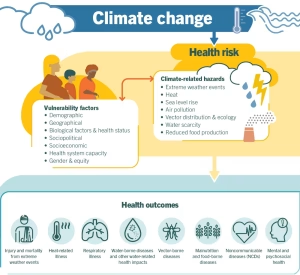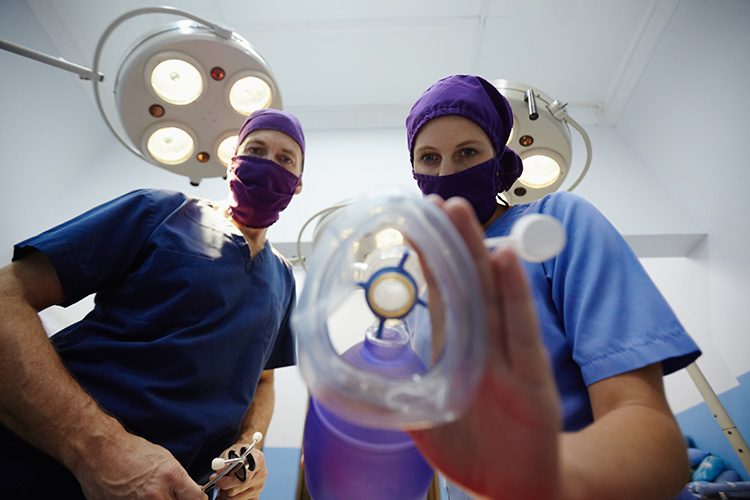Inhalers produce as much carbon emissions as over 500,000 cars each year, study finds – CBS News

Report on the Environmental Impact of Respiratory Inhalers and Alignment with Sustainable Development Goals
1.0 Executive Summary
A recent study published in the Journal of the American Medical Association reveals that common respiratory inhalers are a significant source of greenhouse gas emissions, directly undermining global efforts related to the Sustainable Development Goals (SDGs), particularly SDG 3 (Good Health and Well-being), SDG 12 (Responsible Consumption and Production), and SDG 13 (Climate Action). The research highlights a critical paradox where a medical treatment for respiratory conditions contributes to the environmental degradation that exacerbates these same health issues. The findings call for a systemic shift towards more sustainable healthcare practices and technologies.
2.0 Analysis of Environmental Impact and Link to SDG 13: Climate Action
The report quantifies the substantial carbon footprint of inhalers used for asthma and Chronic Obstructive Pulmonary Disease (COPD) in the United States, presenting a direct challenge to SDG 13, which urges immediate action to combat climate change and its impacts.
- Emission Volume: From 2014 to 2024, these inhalers generated an estimated 24.9 million metric tons of carbon dioxide equivalent emissions.
- Comparative Impact: This annual emission level is comparable to that of approximately 530,000 gasoline-powered vehicles.
- Primary Contributor: Metered-dose inhalers (MDIs) were identified as the source of 98% of these emissions.
- Root Cause: The emissions are not from the medication itself but from the hydrofluoroalkane (HFA) propellants used in MDIs, which are potent greenhouse gases.
3.0 Implications for SDG 3: Good Health and Well-being
The findings expose a detrimental feedback loop that conflicts with the core objectives of SDG 3, which aims to ensure healthy lives and promote well-being for all. The very devices designed to alleviate respiratory suffering are contributing to environmental conditions that worsen public health.
- Inhalers release greenhouse gases, contributing to global warming.
- Climate change and associated air pollution increase the risk and severity of respiratory conditions.
- An estimated 28 million Americans with asthma and 34 million with chronic lung disease are directly affected by worsening air quality.
- This creates a greater dependency on inhalers, perpetuating a cycle of environmental harm and negative health outcomes.
4.0 Addressing SDG 12: Responsible Consumption and Production
The study underscores the urgent need to adopt sustainable consumption and production patterns within the healthcare sector, a key target of SDG 12. The reliance on high-emission medical devices represents an unsustainable model that requires immediate re-evaluation and transition towards environmentally responsible alternatives.
4.1 Comparison of Inhaler Technologies
- Unsustainable Production Model: Metered-dose inhalers (MDIs) rely on HFA propellants, representing a high-carbon footprint technology.
- Sustainable Alternatives: Lower-emission options are readily available and deliver medication effectively without harmful propellants. These include:
- Dry Powder Inhalers (DPIs)
- Soft Mist Inhalers (SMIs)
5.0 Recommendations for a Sustainable Path Forward
To mitigate the environmental impact and align the healthcare sector with the SDGs, a multi-stakeholder approach is necessary. The availability of low-emission alternatives presents a significant opportunity to protect both patient health and planetary health.
- Promote Sustainable Prescribing: Healthcare providers should be educated on the environmental impact of different inhaler types and encouraged to consider lower-emission alternatives where clinically appropriate.
- Foster Industry Innovation: Pharmaceutical companies must be incentivized to accelerate research and development of new, environmentally benign propellants and delivery systems in line with SDG 12.
- Enhance Patient and Public Awareness: Public health campaigns should inform patients about sustainable respiratory care options, empowering them to participate in environmentally conscious healthcare decisions.
- Policy and Systemic Change: Health systems and policymakers should integrate carbon footprint analysis into procurement processes, favoring sustainable medical technologies to advance progress on SDG 3, SDG 12, and SDG 13.
Analysis of Sustainable Development Goals in the Article
1. Which SDGs are addressed or connected to the issues highlighted in the article?
-
SDG 3: Good Health and Well-being
The article directly addresses health issues, specifically chronic respiratory conditions like asthma and chronic obstructive pulmonary disease (COPD). It discusses the treatments (inhalers) for these conditions and how environmental factors, exacerbated by climate change, can worsen them. The article mentions that “Twenty-eight million Americans have asthma and 34 million have chronic lung disease,” highlighting the scale of the health challenge.
-
SDG 12: Responsible Consumption and Production
This goal is relevant because the article focuses on the environmental impact of a specific product: metered-dose inhalers. It critiques the production and consumption patterns of these inhalers due to their use of “hydrofluoroalkane propellants, which are potent greenhouse gases.” The article also points towards more sustainable alternatives like “dry inhalers and soft powder mist inhalers,” advocating for a shift in consumption to reduce environmental harm.
-
SDG 13: Climate Action
This is a central theme of the article. The research discussed quantifies the contribution of inhalers to greenhouse gas emissions, stating they “generated an estimated 24.9 million metric tons of carbon dioxide equivalent emissions in the United States from 2014 to 2024.” The article explicitly links these emissions to global warming and climate change, which in turn worsens the respiratory conditions the inhalers are designed to treat, creating a harmful feedback loop.
2. What specific targets under those SDGs can be identified based on the article’s content?
-
Under SDG 3: Good Health and Well-being
-
Target 3.4: By 2030, reduce by one-third premature mortality from non-communicable diseases through prevention and treatment and promote mental health and well-being.
The article focuses on the treatment of non-communicable diseases (asthma and COPD). The discussion about the environmental impact of treatments and how climate change worsens these conditions is directly related to managing and preventing complications from these diseases.
-
Target 3.9: By 2030, substantially reduce the number of deaths and illnesses from hazardous chemicals and air, water and soil pollution and contamination.
The article connects the worsening of respiratory illnesses to climate change and air pollution. It states, “These cases are expected to grow as climate change makes air pollution worse, increasing the risk and severity of symptoms.” This directly aligns with the goal of reducing illness from air pollution.
-
Target 3.4: By 2030, reduce by one-third premature mortality from non-communicable diseases through prevention and treatment and promote mental health and well-being.
-
Under SDG 12: Responsible Consumption and Production
-
Target 12.4: By 2020, achieve the environmentally sound management of chemicals and all wastes throughout their life cycle… and significantly reduce their release to air, water and soil in order to minimize their adverse impacts on human health and the environment.
The article’s primary focus is on the release of hydrofluoroalkane propellants, which are described as “potent greenhouse gases,” into the atmosphere. This is a direct call for better management of these chemicals in medical products to minimize their environmental impact.
-
Target 12.4: By 2020, achieve the environmentally sound management of chemicals and all wastes throughout their life cycle… and significantly reduce their release to air, water and soil in order to minimize their adverse impacts on human health and the environment.
-
Under SDG 13: Climate Action
-
Target 13.2: Integrate climate change measures into national policies, strategies and planning.
The article’s findings suggest a need for policy and strategy changes within the healthcare sector. The lead author’s statement about the “growing carbon footprint of the US healthcare system” and the “tremendous opportunity to make changes” implies a need to integrate climate considerations into healthcare planning and product regulation.
-
Target 13.3: Improve education, awareness-raising and human and institutional capacity on climate change mitigation, adaptation, impact reduction and early warning.
The study itself, and the article reporting on it, serves to raise awareness among the public, patients, and healthcare professionals about a previously overlooked source of greenhouse gas emissions. This contributes to building institutional capacity within the healthcare system to mitigate its climate impact.
-
Target 13.2: Integrate climate change measures into national policies, strategies and planning.
3. Are there any indicators mentioned or implied in the article that can be used to measure progress towards the identified targets?
- Greenhouse Gas Emissions from the Healthcare Sector: The article provides a direct quantitative indicator: “an estimated 24.9 million metric tons of carbon dioxide equivalent emissions in the United States from 2014 to 2024” from inhalers. This can be used to track progress in reducing emissions from this specific source, aligning with SDG 13.
- Prevalence of Non-Communicable Respiratory Diseases: The article states, “Twenty-eight million Americans have asthma and 34 million have chronic lung disease.” Tracking these numbers over time serves as an indicator for SDG 3, especially in the context of the article’s claim that cases are “expected to grow as climate change makes air pollution worse.”
- Market Share of Environmentally Harmful Products: The article identifies that “metered-dose inhalers… were the most harmful to the environment, accounting for 98% of emissions.” An indicator of progress for SDG 12 would be the reduction in the market share of these specific inhalers in favor of less harmful alternatives like “dry inhalers and soft powder mist inhalers.”
SDGs, Targets, and Indicators Table
| SDGs | Targets | Indicators |
|---|---|---|
| SDG 3: Good Health and Well-being |
|
|
| SDG 12: Responsible Consumption and Production |
|
|
| SDG 13: Climate Action |
|
|
Source: cbsnews.com

What is Your Reaction?
 Like
0
Like
0
 Dislike
0
Dislike
0
 Love
0
Love
0
 Funny
0
Funny
0
 Angry
0
Angry
0
 Sad
0
Sad
0
 Wow
0
Wow
0



















































.jpg.webp?itok=0ZsAnae9#)
























